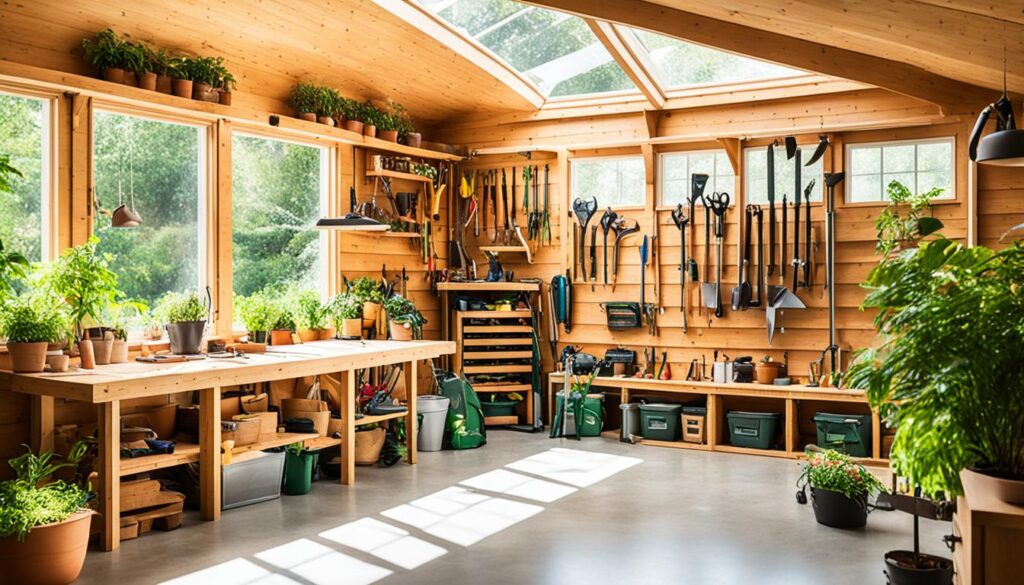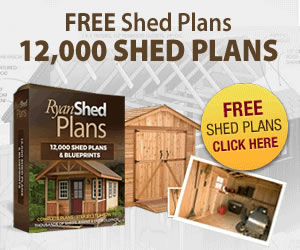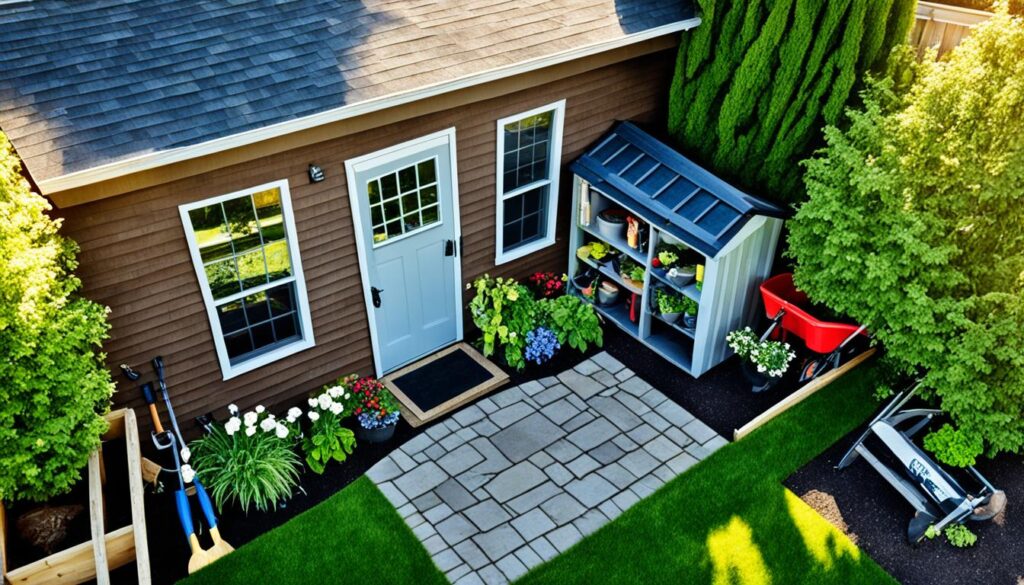Building Your Dream Tool Shed: A Comprehensive Guide
Join us on the journey to create your dream tool shed. Our goal is to help you, whether you’re experienced or new to DIY. We offer key tips on planning, designing, and building. We also tell you how to add the perfect finish for your shed to match your outdoor area.

Key Takeaways
- Understand your specific requirements and intended use of the tool shed.
- Select a suitable location considering accessibility and sunlight exposure.
- Familiarize yourself with local regulations and acquire necessary permits.
- Explore different shed styles and materials to match your aesthetic and functional needs.
- Consider shed kits for a simplified construction process.
- Implement effective storage solutions to maximize internal space and function.
- Personalize your shed with unique touches to integrate it seamlessly with your outdoor environment.
Check out some shed examples Here
Planning Your Shed Project
Starting a shed project? Take a step-by-step approach for the best results. Smart planning can save you time, effort, and money.
Assessing Your Needs and Requirements
Start by figuring out why you need a shed. Is it for garden tool storage, as a workshop, or just a quiet place outside? Knowing this will help you pick the right size and design. Also, think about the tools and other items you want to keep there, and what you need the shed to do.
Choosing the Right Location
The spot for your shed is key. Think about how easy it is to reach, how much sun it gets, and if the ground is level for the base. It should also be close to your home or work area for easy access.
Checking Local Regulations and Permits
Don’t forget about local rules and permits before you start building. Some places have strict rules on shed sizes or where you can put them. Making sure you have the right permits can help you avoid problems later on.
Here’s a handy checklist for planning your shed:
| Task | Considerations | Notes |
|---|---|---|
| Assess Needs | decide its use, what’s going in it | Figure out dimensions and layout |
| Select Location | think about access, sunlight, and the ground | Outline the space |
| Verify Regulations | Know the local rules and what permits you need | Call city hall for information |
Plan well to make your shed project a success. It’s important to think about both how it works and how it looks. This makes for a well-organized and attractive outdoor area.

Designing Your Shed
Starting a DIY shed project gives you the freedom to customize it just right. You can pick a design that fits your space and style. Then, choose the best materials to make your shed not just look good but also work well.
Shed Styles and Designs
Choosing the style for your shed design is fun. You can go with a classic look like the gable or something unique like the saltbox. The gable style has a simple yet elegant roof, great for most uses. The gambrel style, with its barn-like appearance, provides lots of storage space under its sloping roof.
Shed Materials
The materials you choose are crucial. Wood looks good but needs more care. Metal lasts a long time and is tough against pests. Vinyl sheds are great if you want something low maintenance that lasts a while without much upkeep.
Shed Layout and Floor Plan
Planning your shed’s layout means thinking about how you’re going to use it. It’s best to divide your space for different things. You could have an area for your tools, another for working, and space for hanging up what you need. This way, every part of your shed is working hard for you, making your shed perfect for your diy shed project or for smart shed storage.
| Shed Style | Features | Best For |
|---|---|---|
| Gable | Simple, peaked roof | General use |
| Gambrel | High-sloping roof, ample storage | Storage-heavy needs |
| Saltbox | Asymmetrical roof, unique design | Residential appeal |
| Lean-to | Slanted roof, easy to build | Small spaces |
Exploring Shed Kits
Shed kits are the go-to choice for easy building. They come in different sizes and styles. This makes building your own shed simpler with all pieces cut and sometimes drilled already.

- Pre-cut materials for ease of assembly
- Ideal for both small and large backyard shed projects
- Customizable options to cater to different needs
Using shed kits helps you save time and hard work. This means building your shed is more enjoyable and straightforward. They also include clear instructions, great for beginners. Shed kits fit any preference, from small storage sheds to bigger, customizable ones.
| Feature | Details |
|---|---|
| Sizes | Ranging from 6×4 to 12×16 |
| Designs | Traditional, Modern, Rustic |
| Material Options | Wood, Metal, Vinyl |
Finding the right backyard shed kit is easy. There are many options, perfect for storage or workspace needs. They are a top pick for anyone’s next DIY project.
Check out some shed examples Here
Building Your Shed
Starting your shed project involves several important steps, each crucial for a strong, functional storage space. We will walk you through building your shed, from basics like the foundation to adding doors, windows, and a roof.
Preparing the Foundation
The first step is to create a solid base for your shed. You might choose a concrete slab or wooden skids based on your plan and location. It is vital to ensure the ground is level and the size fits your design. A good foundation ensures safety and lasting durability for the shed.
Framing the Shed
With a solid base, framing comes next. This is where your shed starts to take shape. Use accurate measurements and secure every piece of lumber tightly. Frame your shed carefully. Following a detailed plan will make sure the frame is strong and stable.
Installing Doors, Windows, and Roofing
After the framing, add the doors, windows, and roof. These parts do more than look nice. They improve how you use your shed. Strong, well-fitted doors keep things secure, and windows provide light and air inside. Choose a durable roof material to protect your shed from the weather.
Then, finish by painting the outside and organizing the inside. This doesn’t just make it look good. It also helps your shed last longer, making your time and money well spent.
| Construction Phase | Key Considerations |
|---|---|
| Foundation | Level ground, concrete slab or wood skids, accurate measurements |
| Framing | Precise measurements, secure joints, quality lumber |
| Doors and Windows | Sturdy doors, proper fitting, natural light, ventilation |
| Roofing | Durability, weather resistance |
| Finishing | Painting or staining, interior organization |
Best Practices for Shed Storage Solutions
Keeping your tool shed neat and well-organized is key. It makes your tools easy to find and helps them last longer. By using the right storage solutions, you can turn your shed into a more efficient space. Let’s look at some advice for better storage in your shed.
Maximizing Internal Space
You need to think smartly to make the most of the shed’s inside. First, use the walls. Adding shelves can keep small things in order and close at hand. You can also put up racks on the ceiling for items you don’t use all the time or for larger tools. This way, you save space on the ground and use every part of your shed well.
Tools and Equipment Organization
It’s vital to organize your tools and gear well. Pegboards are great for this, as they let you design your space to fit your needs. Hooks and brackets on them make it easy to grab your tools when you need them. Also, consider cabinets or caddies on wheels. They help keep your tools safe and your shed tidy. This means less clutter and more protection for your tools.
- Install wall shelves for small items
- Use ceiling-mounted racks for bulky storage
- Set up a pegboard system for tool arrangement
- Consider mobile caddies for flexible storage
Following these steps can turn your shed into an organized space. A place where each tool and piece of equipment has its own spot. This makes your work area more productive and enjoyable.
| Storage Solution | Benefits |
|---|---|
| Wall Shelving | Maximizes vertical space, keeps small items accessible |
| Ceiling-Mounted Racks | Stores large items overhead, frees up floor space |
| Pegboard System | Customizable tool organization, easy access |
| Mobile Caddies | Flexible storage, easy to move items around |
By using these advice about shed storage solutions, you can make a big difference. Your shed will be organized, making it easy to find and use your tools. With these tips, working in your shed is less complicated and more pleasant.
Materials and Tools for Shed Construction
Selecting the right shed construction materials is key for your DIY shed project. You can choose from wood, metal, or vinyl based on what you need. Wood looks traditional, metal is strong, and vinyl is easy to care for.
For the perfect shed, you need the right tools for building it. Here’s a list of must-haves:
- Hammer
- Saw
- Drills
- Measuring equipment
- Level
- Utility Knife
- Screwdrivers
- Pencils and Markers
Using these tools right helps make your shed sturdy and good-looking. A prepared list of garden storage ideas also makes shed building easier and quicker.

Customizing Your Tool Shed
Adding your personal touch to a tool shed can turn it into a special part of your backyard. Focus on unique details. Combine beauty with usefulness to create an enjoyable shed.
Adding Personal Touches
Start by picking a paint color that matches your home or garden theme. Add unique hardware like vintage handles or eye-catching hinges. Decorate with items that show your hobbies to make the shed feel like yours.
Integrating the Shed with Your Garden
Integrating your shed into your garden can make it more beautiful. Place planters on the walls with pretty plants. Use a pathway to connect the garden and shed, making the space feel together and inviting.
Optimizing for Functionality
Think about what you’ll use the shed for to make it work well for you. Install wiring for power tools to use electricity safely. Make sure there’s good ventilation to keep the air fresh.
Adding workbenches and shelves helps keep things organized. This makes your tools easy to find.
A carefully designed shed will complement your garden and serve your needs well. By combining personal style with smart additions, you can create a shed you’ll enjoy spending time in.
Shed Maintenance Tips
Regular shed maintenance is essential for keeping your tool shed in top shape. These tasks help it last longer, stay safe, and work as a storage space.
First, examine the shed’s exterior for damage. Look for broken panels, rust, or leaks. Fixing these early prevents bigger problems later.
Keep the shed’s outside clean by removing leaves, dirt, and other debris. This prevents mold and pest damage.
Also, adding paint or sealant can help your shed last longer. These act as shields against the weather. Reapply every few years to keep your shed protected.
Check hardware like hinges and locks regularly to ensure they work well. Greasing moving parts stops rust and keeps things running smoothly.
| Maintenance Task | Frequency | Benefits |
|---|---|---|
| Inspecting structure for damage | Quarterly | Prevents extensive repairs |
| Cleaning exterior | Monthly | Avoids mold and pests |
| Applying protective treatments | Every 2-3 years | Extends shed life |
| Checking and lubricating hardware | Biannually | Ensures functionality |
Use these tips regularly for your garden storage maintenance. They will keep your shed in great shape for many years.
Conclusion
Starting your own custom tool shed project is very rewarding. With good diy shed plans, building becomes easy. You move from planning to making it look great in small steps.
Building a shed can seem hard, but with guides like those on MyShedPlans.com, it’s simpler. You can pick from many designs for any skill level. Whether simple or detailed, you’ll find the plan that fits what you want.
“Your dream tool shed is more than a utility space; it’s a reflection of your creativity and effort. Embrace the process and enjoy the satisfaction of seeing your visions come to life.”

Let’s remember the important things for your project: Planning well, using good materials, and starting strong are key. Take care in each building step for a better shed. Keep in mind, every shed is different, showing the builder’s style.
| Essential Steps | Main Considerations |
|---|---|
| Planning | Location selection, space requirements |
| Designing | Style, materials, layout |
| Construction | Foundation, framing, installation |
| Customization | Personal touches, functional optimizations |
In the end, researching and enjoying the hands-on work make your shed special. Let’s build your custom tool shed one step at a time, bringing your plans to life.
FAQs (Frequently Asked Questions)
We’ve talked with many DIY fans about building backyard sheds. They’ve asked lots of backyard shed FAQs. Knowing the answers to these diy shed project questions is crucial. It gives you a head start. Let’s look at some of the top questions and their answers:
- How long does it take to build a shed? Building a shed can take a few days to a few weeks, depending on the shed’s design and the builder’s skill level.
- Can I customize my shed design? Yes, you can make your shed unique. Change its size, add doors, windows, or special storage. Shed kits also allow for unique customizations.
- Is professional help necessary? Some people build sheds on their own successfully. But, hiring experts for specific tasks, like wiring, is also an option. You should think about what you’re comfortable doing.
- Can I tackle this project alone? Yes, you can work on a shed project by yourself. Having friends help out, especially with heavy lifting, can make things easier.
- What are the maintenance requirements for a shed? Sheds need regular checks for damage and exterior cleaning. Using paint or sealants helps protect the shed. This care keeps your shed working and looking good for longer.
Knowing the answers to these backyard shed FAQs is key to a successful project. Tackling diy shed project questions head-on ensures you are ready for each step, turning your backyard shed dream into a real project.
Get Inspired: Creative Ideas for Your Tool Shed
A tool shed is more than a place to store items. It can be your personal haven, showing off what you love and who you are. You could turn your shed into an art studio, a peaceful reading corner, or a calming garden spot. With just a little creativity, your shed becomes something special.
Think about what you really want from your shed. Do you need a quiet spot to relax, away from the busy world? Or do you want a perfect place for your hobbies? Let your design choices show your style, whether that’s rustic, modern, or vintage.
Keeping your shed neat and looking good is key. You can use shelves, pegboards, and cabinets to store tools smartly. Choose furniture that does more than one job to save space. Backyard Outfitters has lots of tips to make your shed practical and stylish. With a little DIY, you can create a space that’s all about function, fun, and getting things done.
Check out some shed examples Here
FAQ
How long does it take to build a tool shed?
Building a tool shed takes different amounts of time. It can be quick or slow, depending on how hard or easy it is to make. For someone who knows a bit, it might take from the end of the week to the next weekend.
Can I customize my shed design?
Yes, you can make your shed special to fit your needs. Pick your favorite look, materials, and setup. Add your own twist with cool paint or unique knobs.
Do I need a permit to build a shed?
Whether you need a permit depends on where you live. It’s smart to ask your local government about this. They can tell you about any rules you might need to follow.
What are the key steps in maintaining a tool shed?
Taking care of your shed is vital. Look for any damage, keep it clean, and protect it from the weather. Also, don’t let stuff pile up inside.
What materials are best for building a tool shed?
The best materials are those that fit what you want and look good. Wood is traditional, metal is tough, and vinyl needs less care. Each one has benefits. Pick the one that works best for you.
How can I optimize the storage in my tool shed?
To make the most of your shed’s space, put up shelves and hooks. This keeps everything neat. So, your shed is more useful and looks better too.
Are shed kits a good option for beginners?
Shed kits are great for starters. They have everything cut and ready to use. And the instructions are clear. This makes it easier to put the shed together even if you’re not a pro.
What tools do I need to construct a tool shed?
You’ll need some basic tools such as a hammer, a saw, and a drill. Also, grab a tape measure and a level for accuracy. Having all these tools ready helps get the job done right.
Can I build a shed independently, or should I get help?
Building a shed alone is doable but slower. It’s easier and faster with a partner, especially when you need to be precise or handle heavy things. If you’re just starting out, a helping hand is a good idea.
How can I integrate my shed with my garden?
Make your shed a part of your garden with pretty planters or a nice path. Use matching decorations to link your shed to the outdoors. This makes your garden and shed look like they belong together.



